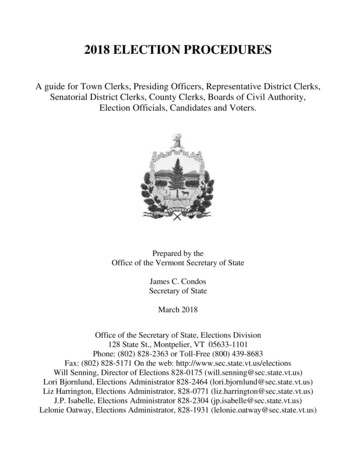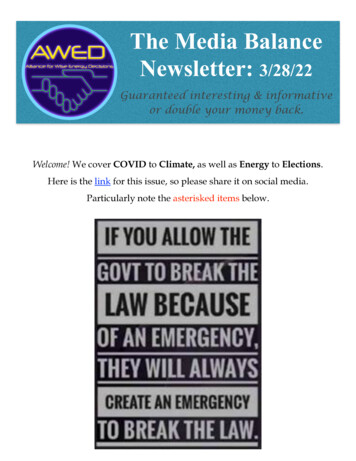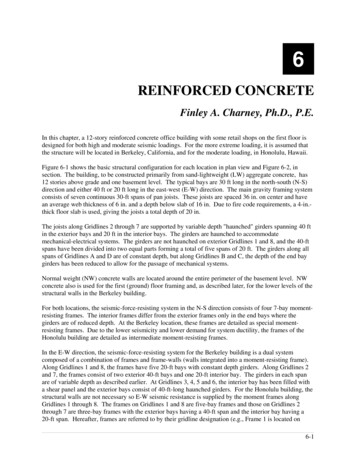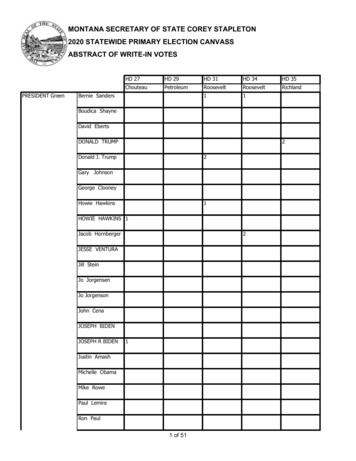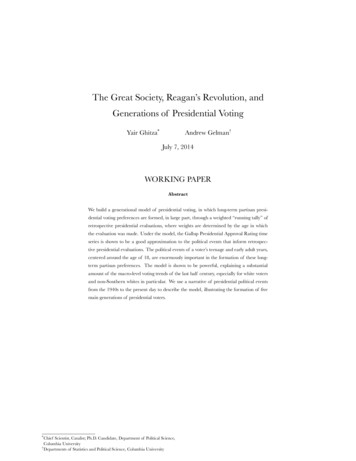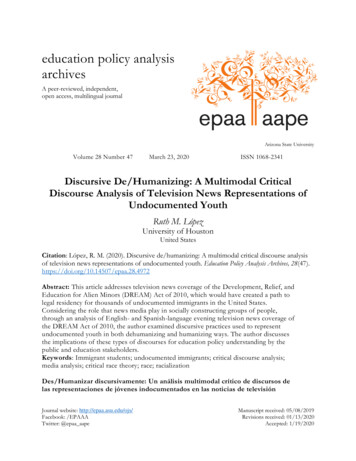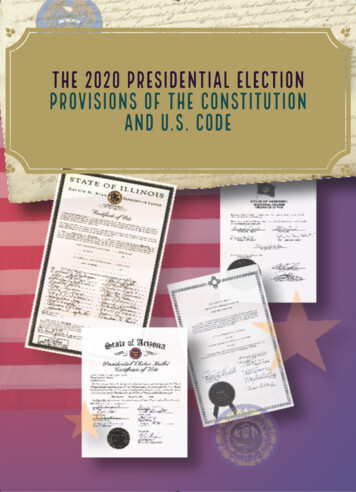
Transcription
PREFACEThe National Archives and Records Administration (NARA) is proud to acknowledge its role in the Presidential election process. NARA’s Office of the Federal Register (OFR) acts as the administrator of the Electoral College and carries out the dutiesof the Archivist. In this role, the OFR is charged with helping the States carry out their election responsibilities, ensuring thecompleteness and integrity of the Electoral College documents submitted to Congress, and informing the public about thePresidential election process.The Electoral College system was established under Article II and Amendment 12 of the U.S. Constitution. In each State, thevoters choose electors to select the President and Vice President of the United States, based on the results of the November general election.Before the general election, the Archivist officially notifies each State’s governor and the Mayor of the District of Columbiaof their electoral responsibilities. OFR provides instructions and resources to help the States and District of Columbia carryout those responsibilities. As the results of the popular vote are finalized in each state, election officials create Certificatesof Ascertainment, which establish the credentials of their electors, that are sent to OFR. In December, the electors holdmeetings in their States to vote for President and Vice President. The electors seal Certificates of Vote and send them to theOFR and Congress. In January, Congress sits in joint session to certify the election of the President and Vice President. In theyear after the election, electoral documents are held at the OFR for public viewing, and then transferred to the Archives ofthe United States for permanent retention and access.In this Presidential election year, the cover of this pamphlet shows a representation of the Electoral College system in celebration of the spirit of the American democratic process.For more information on the Electoral College, visit NARA’s web site at:https://www.archives.gov/electoral-college/Our thanks are extended to the Creative Services Division of the U.S. Government Printing Office for its assistance in developingthis cover.
This pamphlet has been compiled and published by the Office of the Federal Register, National Archives andRecords Administration, for use by the Executives and Electors of the several States in the performance of theirduties in connection with Presidential Elections.[Revised July 2020]
TABLE OF CONTENTS2020 Presidential Election Summary of Key Dates, Events and Information 42020 List of States and Votes . 6CONSTITUTION OF THE UNITED STATES . .7Article II . Twelfth Amendment . Fourteenth Amendment . Fifteenth Amendment . Nineteenth Amendment . Twentieth Amendment . .Twenty-Second Amendment . Twenty-Third Amendment . Twenty-Fourth Amendment . Twenty-Fifth Amendment . Twenty-Sixth Amendment . 77778888899UNITED STATES CODE . .CHAPTER 1. PRESIDENTIAL ELECTIONS AND VACANCIES . §1§2§3§4§5§6§7§8§9§ 10§ 11§ 12§ 13§ 14§ 15§ 16§ 17§ 18§ 19§ 20§ 21Time of Appointing Electors . Failure to Make Choice on Prescribed Day Number of Electors . .Vacancies in Electoral College Determination of Controversy as to Appointment of Electors .Credentials of Electors; Transmission to Archivist of the United States and to Congress;Public Inspection . .Meeting and Vote of Electors .Manner of Voting . .Certificates of Votes for President and Vice President .Sealing and Endorsing Certificates Disposition of Certificates .Failure of Certificates of Electors to Reach President of the Senateor Archivist of the United States; Demand on State for Certificate .Same; Demand on District Judge for Certificate Forfeiture for Messenger’s Neglect of Duty .Counting Electoral Votes in Congress Same; Seats for Officers and Members of Two Houses in Joint Meeting Same; Limit of Debate in Each House .Same; Parliamentary Procedure at Joint Meeting .Vacancy in Offices of Both President and Vice President; Officers Eligible to Act Resignation or Refusal of Office .Definitions . .MORE INFORMATION . he 2020 Presidential Election/Provisions of the Constitution and U.S. Code
2020 PRESIDENTIAL ELECTIONSummary of Key Dates, Events and InformationGeneral Authority:The Archivist of the United States, as the head of the National Archives and Records Administration (NARA), is responsible for carrying out ministerial duties on behalf ofthe States and the Congress under 3 U.S.C. sections 6, 11,12, and 13. NARA is primarily responsible for coordinatingthe various stages of the electoral process by helping theStates prepare and submit certificates that establish theappointment of electors and validate the electoral votes ofeach State. The Archivist delegates operational duties tothe Director of the Federal Register. Office of the FederalRegister (OFR) staff ensures that electoral documents aretransmitted to Congress, made available to the public, andpreserved as part of our nation’s history. OFR staff reviewsthe electoral certificates for the required signatures, seals,and other matters of form, as specified in Federal law. Onlythe Congress and the Courts have the authority to rule onsubstantive legal issues.In this pamphlet, the word “State” also refers to the Districtof Columbia and the word “Governor” also refers to theMayor of the District of Columbia.3. Mid-November through December 14, 2020Sending Certificates of Ascertainment to NARA:The Certificates of Ascertainment list the names of the electorsappointed and the number of votes cast for each person. The States prepares no less than SEVEN originals, which areauthenticated by the Governor’s signature and the State seal,and TWO certified copies. Alternatively, NINE originals may beprepared.One original along with two certified copies (or three originals,if nine were prepared) must be sent to the Archivist, David S.Ferriero, c/o Office of the Federal Register (F).The Governors must submit the Certificates of Ascertainment“as soon as practicable” after their States certify election results. The remaining SIX original Certificates of Ascertainment willbe attached to the Certificates of Vote at the State meetings.1. June through October 2020Preparation Stage:4. December 8, 2020OFR Legal staff prepare letters and instructional materialsfor the Archivist to send to the Governors of the 50 Statesand the Mayor of the District of Columbia.Date for Determination of Controversy as to Appointment ofElectors: States must make final determinations of any controversiesThe materials include this pamphlet and detailed instructions on how to prepare and submit the electors’ credentials (Certificates of Ascertainment) and the electoral votes(Certificates of Vote).or contests as to the appointment of electors at least six daysbefore the December 14 meetings of electors for their electoralvotes to be presumptively valid when presented to Congress.Determinations by States’ lawful tribunals are conclusive, ifdecided under laws enacted prior to election day. During the summer and fall, OFR Legal staff begin con-5. December 14, 2020tacting Governors and Secretaries of State to establish contacts for the coming election.Meeting of the Electors and Sending Certificates of Vote toNARA (first Monday after second Wednesday in December): The electors meet in their respective States to select the2. November 3, 2020General Election (first Tuesday after first Monday inNovember): The voters in each State choose slates of electors toserve in the Electoral College. Forty-eight of the fifty Statesand the District of Columbia are “winner-take all” (Maineand Nebraska are the exceptions).President and Vice President of the United States. No Constitutional provision or Federal law requires electors to vote in accordance with the popular vote in their States. The SupremeCourt decided (in 2020) that States can enact requirements onhow electors vote. The Electoral College web site lists theStates that we are aware of that have laws to bind electors tocandidates.The electors record their votes on SIX “Certificates of Vote,”The 2020 Presidential Election/Provisions of the Constitution and U.S. Code4
which are then paired with the SIX remaining originalCertificates of Ascertainment. After signing the Certificates of Vote, the electors sealand certify the electoral votes in packages containing apaired original Certificate of Ascertainment and originalCertificate of Vote. They immediately distribute thepaired certificates as follows: One pair of original certificates is sent to the President8. January 6, 2021Counting Electoral Votes in Congress: The Congress meets in joint session to count the electoralvotes. The President of the Senate is the presiding officer. If aSenator and a House member jointly submit an objection, eachHouse would retire to its chamber to consider it.of the Senate (Michael R. Pence) Two pairs of original certificates are sent to the Archivist, David S. Ferriero, c/o Office of the Federal Register(F)The Archivist holds one pair subject to the order of thePresident of the United States Senate in case the electoral votes fail to reach the Senate. The other pair is heldby the Office of the Federal Register for public inspectionfor one year.The President and Vice President must achieve a majority ofelectoral votes (270) to be elected. In the absence of a majority,the House selects the President, and the Senate selects the VicePresident.If a State submits conflicting electoral votes to Congress, the twoHouses acting concurrently may accept or reject them. If they donot concur, the votes of the electors certified by the Governor ofthe State would be counted in Congress. Two pairs of certificates are sent by registered mail tothe Secretary of State of each State, who holds one pairsubject to the order of the President of the United StatesSenate in case the electoral votes fail to reach the Senate.9. January 20, 2021 at Noon One pair of original certificates is sent to the ChiefOffice and become the President of the United States and VicePresident of the United States, respectively.Judge of the Federal District Court located where theelectors meet. It is held subject to the order of the President of the United States Senate or the Archivist of theUnited States in case the electoral votes fail to reach theSenate or the Archivist.Inauguration: The President-elect and Vice President-elect take the Oath of6. December 23, 2020Deadline for Receipt of Electoral Votes at NARA (no laterthan nine days after the meeting of the electors): The President of the Senate and the Archivist shouldhave the electoral votes in hand by December 23, 2020.If votes are lost or delayed, the Archivist may take extraordinary measures to retrieve duplicate originals.7. On or Before January 3, 2021Transfer of Certificates to Congress: As the new Congress assembles, the Archivist transmitssets of Certificates to Congress, as requested. This generally happens when the Senate does not receive its set ofCertificates on time. The transfer occurs in late December or early January when OFR’s Legal staff meets withrepresentatives of the Secretary of the Senate and theClerk of the House.The 2020 Presidential Election/Provisions of the Constitution and U.S. Code5
2020 LIST OF STATES AND VOTESAllocation of Electoral Votes(based on the 2010 census)Total: 538; Majority Needed to Elect: 270Alabama – 9Montana – 3Alaska – 3Nebraska – 5Arizona – 11Nevada – 6Arkansas – 6New Hampshire – 4California – 55New Jersey – 14Colorado – 9New Mexico – 5Connecticut – 7New York – 29Delaware – 3North Carolina – 15District of Columbia – 3North Dakota – 3Florida – 29Ohio – 18Georgia – 16Oklahoma – 7Hawaii – 4Oregon – 7Idaho – 4Pennsylvania – 20Illinois – 20Rhode Island – 4Indiana – 11South Carolina – 9Iowa – 6South Dakota – 3Kansas – 6Tennessee – 11Kentucky – 8Texas – 38Louisiana – 8Utah – 6Maine – 4Vermont – 3Maryland – 10Virginia – 13Massachusetts – 11Washington – 12Michigan – 16West Virginia – 5Minnesota – 10Wisconsin – 10Mississippi – 6Wyoming – 3Missouri – 10The 2020 Presidential Election/Provisions of the Constitution and U.S. Code6
CONSTITUTION OF THE UNITED STATESARTICLE IISECTION 1. The executive Power shall be vested in a President of the United States of America. He shall hold hisOffice during the Term of four Years, and, together with theVice President, chosen for the same Term, be elected, asfollowsEach State shall appoint, in such Manner as the Legislaturethereof may direct, a Number of Electors, equal to thewhole Number of Senators and Representatives to whichthe State may be entitled in the Congress: but no Senator orRepresentative, or Person holding an Office of Trust orProfit under the United States, shall be appointed an Elector.******The Congress may determine the Time of chusing the Electors, and the Day on which they shall give their Votes; whichDay shall be the same throughout the United States.TWELFTH AMENDMENTThe Electors shall meet in their respective states, and voteby ballot for President and Vice-President, one of whom, atleast, shall not be an inhabitant of the same state withthemselves; they shall name in their ballots the person voted for as President, and in distinct ballots the person votedfor as Vice-President, and they shall make distinct lists of allpersons voted for as President, and of all persons voted foras Vice-President, and of the number of votes for each,which lists they shall sign and certify, and transmit sealed tothe seat of the government of the United States, directed tothe President of the Senate; The President of the Senateshall, in the presence of the Senate and House of Representatives, open all the certificates and the votes shall thenbe counted;—The person having the greatest number ofvotes for President, shall be the President, if such numberbe a majority of the whole number of Electors appointed;and if no person have such majority, then from the personshaving the highest numbers not exceeding three on the listof those voted for as President, the House of Representatives shall choose immediately, by ballot, the President. Butin choosing the President, the votes shall be taken bystates, the representation from each state having one vote;a quorum for this purpose shall consist of a member ormembers from two-thirds of the states, and a majority ofall the states shall be necessary to a choice. The personhaving the greatest number of votes as Vice-President,shall be the Vice-President, if such number be a majority ofthe whole number of Electors appointed, and if no personhave a majority, then from the two highest numbers on thelist, the Senate shall choose the Vice-President; a quorumfor the purpose shall consist of two-thirds of the wholenumber of Senators, and a majority of the whole numbershall be necessary to a choice. But no person constitutionally ineligible to the office of President shall be eligible tothat of Vice-President to the United States.FOURTEENTH AMENDMENTSECTION 1. All persons born or naturalized in the UnitedStates, and subject to the jurisdiction thereof, are citizensof the United States and the State wherein they reside. NoState shall make or enforce any law which shall abridge theprivileges or immunities of citizens of the United States;nor shall any State deprive any person of life, liberty, orproperty, without due process of law; nor deny to any person within its jurisdiction the equal protection of the laws.******SECTION 3. No person shall be elector of President andVice President who, having previously taken an oath, as amember of Congress, or as an officer of the United States,or as a member of any State legislature, or as an executiveor judicial officer of any State, to support the Constitutionof the United States, shall have engaged in insurrection orrebellion against the same, or given aid or comfort to theenemies thereof. But Congress may by a vote of two-thirdsof each House, remove such disability.FIFTEENTH AMENDMENTSECTION 1. The right of citizens of the United States tovote shall not be denied or abridged by the United Statesor by any State on account of race, color, or previous condition of servitude.******The 2020 Presidential Election/Provisions of the Constitution and U.S. Code7
NINETEENTH AMENDMENTTWENTY-SECOND AMENDMENTThe right of citizens of the United States to vote shall not be denied or abridged by the United States or by any State on accountof sex.******SECTION 1. No person shall be elected to the office ofthe President more than twice, and no person who hasheld the office of President, or acted as President, for morethan two years of a term to which some other person waselected President shall be elected to the office of the President more than once. But this Article shall not apply to anyperson holding the office of President when this Article wasproposed by the Congress, and shall not prevent any person who may be holding the office of President, or actingas President, during the term within which this Article becomes operative from holding the office of President oracting as President during the remainder of such term.******TWENTIETH AMENDMENTSECTION 1. The terms of the President and Vice President shallend at noon on the 20th day of January, and the terms of Senators and Representatives at noon on the 3d day of January, of theyears in which such terms would have ended if this article hadnot been ratified; and the terms of their successors shall thenbegin.SECTION 2. The Congress shall assemble at least once in everyyear, and such meeting shall begin at noon on the 3d day of January, unless they shall by law appoint a different day.SECTION 3. If, at the time fixed for the beginning of the term ofthe President, the President elect shall have died, the Vice President elect shall become President. If a President shall not havebeen chosen before the time fixed for the beginning of his term,or if the President elect shall have failed to qualify, then the VicePresident elect shall act as President until a President shall havequalified; and the Congress may by law provide for the casewherein neither a President elect nor a Vice President elect shallhave qualified, declaring who shall then act as President, or themanner in which one who is to act shall be selected, and suchperson shall act accordingly until a President or Vice Presidentshall have qualified.SECTION 4. The Congress may by law provide for the case ofthe death of any of the persons from whom the House of Representatives may choose a President whenever the right of choiceshall have devolved upon them, and for the case of the death ofany of the persons from whom the Senate may choose a VicePresident whenever the right of choice shall have devolved uponthem.******TWENTY-THIRD AMENDMENTSECTION 1. The District constituting the seat of Government of the United States shall appoint in such manner asthe Congress may direct:A number of electors of President and Vice President equalto the whole number of Senators and Representatives inCongress to which the District would be entitled if it were aState, but in no event more than the least populous State;they shall be in addition to those appointed by the States,but they shall be considered, for the purposes of the election of President and Vice President, to be electors appointed by a State; and they shall meet in the District andperform such duties as provided by the twelfth article ofamendment.******TWENTY-FOURTH AMENDMENTSECTION 1. The right of citizens of the United States tovote in any primary or other election for President or VicePresident, for electors for President or Vice President, orfor Senator or Representative in Congress, shall not be denied or abridged by the United States or any State by reason of failure to pay any poll tax or other tax.******The 2020 Presidential Election/Provisions of the Constitution and U.S. Code8
TWENTY-FIFTH AMENDMENTTWENTY-SIXTH AMENDMENTSECTION 1. In case of the removal of the President from office orof his death or resignation, the Vice President shall become President.SECTION 2. Whenever there is a vacancy in the office of the VicePresident, the President shall nominate a Vice President who shalltake office upon confirmation by a majority vote of both Houses ofCongress.SECTION 1. The right of citizens of the United States,who are eighteen years of age or older, to vote shall notbe denied or abridged by the United States or by anyState on account of age.******SECTION 3. Whenever the President transmits to the Presidentpro tempore of the Senate and the Speaker of the House of Representatives his written declaration that he is unable to discharge thepowers and duties of his office, and until he transmits to them awritten declaration to the contrary, such powers and duties shall bedischarged by the Vice President as Acting President.SECTION 4. Whenever the Vice President and a majority of eitherthe principal officers of the executive departments or of such otherbody as Congress may by law provide, transmit to the Presidentpro tempore of the Senate and the Speaker of the House of Representatives their written declaration that the President is unable todischarge the powers and duties of his office, the Vice Presidentshall immediately assume the powers and duties of the office asActing President.Thereafter, when the President transmits to the President pro tempore of the Senate and the Speaker of the House of Representatives his written declaration that no inability exists, he shall resumethe powers and duties of his office unless the Vice President and amajority of either the principal officers of the executive department or of such other body as Congress may by law provide, transmit within four days to the President pro tempore of the Senateand the Speaker of the House of Representatives their written declaration that the President is unable to discharge the powers andduties of his office. Thereupon Congress shall decide the issue, assembling within forty-eight hours for that purpose if not in session.If the Congress, within twenty-one days after receipt of the latterwritten declaration, or, if Congress is not in session, within twentyone days after Congress is required to assemble, determines bytwo-thirds vote of both Houses that the President is unable to discharge the powers and duties of his office, the Vice President shallcontinue to discharge the same as Acting President; otherwise, thePresident shall resume the powers and duties of his office.The 2020 Presidential Election/Provisions of the Constitution and U.S. Code9
UNITED STATES CODEThe following provisions of law governing Presidential Elections are contained in Chapter 1 of Title 3, United States Code (62 Stat. 672, as amended):Title 3 — The PresidentChapter 1Presidential Elections and VacanciesSection1.Time of appointing electors.2.Failure to make choice on prescribed day.3.Number of electors.4.Vacancies in electoral college.5.Determination of controversy as to appointment of electors.6.Credentials of electors; transmission to Archivist ofthe United States and to Congress; public inspection.7.Meeting and vote of electors.8.Manner of voting.9.Certificates of votes for President and Vice President.10. Sealing and endorsing certificates.11. Disposition of certificates.12. Failure of certificates of electors to reach President of the Senate orArchivist of the United States; demand on State for certificate.13. Same; demand on district judge for certificate.14. Forfeiture for messenger’s neglect of duty.15. Counting electoral votes in Congress.16. Same; seats for officers and Members of two Houses in jointmeeting.17. Same; limit of debate in each House.18. Same; parliamentary procedure at joint meeting.19. Vacancy in offices of both President andVice President; officers eligible to act.20. Resignation or refusal of office.21. Definitions.The 2020 Presidential Election/Provisions of the Constitution and U.S. Code10
Time of Appointing Electors§ 1. The electors of President and Vice President shall be appointed, in each State, on the Tuesday next after the first Monday in November, in every fourth year succeeding every election of a President and Vice President.Failure to Make Choice on Prescribed Day§ 2. Whenever any State has held an election for the purpose ofchoosing electors, and has failed to make a choice on the dayprescribed by law, the electors may be appointed on a subsequent day in such a manner as the legislature of such State maydirect.Number of Electors§ 3. The number of electors shall be equal to the number ofSenators and Representatives to which the several States are bylaw entitled at the time when the President and Vice Presidentto be chosen come into office; except, that where no apportionment of Representatives has been made after any enumeration,at the time of choosing electors, the number of electors shall beaccording to the then existing apportionment of Senators andRepresentatives.Vacancies in Electoral College§ 4. Each State may, by law, provide for the filling of any vacancies which may occur in its college of electors when such collegemeets to give its electoral vote.Determination of Controversy as to Appointmentof Electorsed in the Constitution, and as hereinafter regulated, so far asthe ascertainment of the electors appointed by such State isconcerned.Credentials of Electors; Transmission to Archivistof The United States and to Congress; Public Inspection§ 6. It shall be the duty of the executive of each State, as soonas practicable after the conclusion of the appointment of theelectors in such State by the final ascertainment, under and inpursuance of the laws of such State providing for such ascertainment, to communicate by registered mail under the seal ofthe State to the Archivist of the United States a certificate ofsuch ascertainment of the electors appointed, setting forth thenames of such electors and the canvass or other ascertainment under the laws of such State of the number of votes given or cast for each person for whose appointment any and allvotes have been given or cast; and it shall also thereupon bethe duty of the executive of each State to deliver to the electors of such State, on or before the day on which they are required by section 7 of this title to meet, six duplicate-originalsof the same certificate under the seal of the State; and if thereshall have been any final determination in a State in the manner provided for by law of a controversy or contest concerningthe appointment of all or any of the electors of such State, itshall be the duty of the executive of such State, as soon aspracticable after such determination, to communicate underthe seal of the State to the Archivist of the United States acertificate of such determination in form and manner as thesame shall have been made; and the certificate or certificatesso received by the Archivist of the United States shall be preserved by him for one year and shall be a part of the publicrecords of his office and shall be open to public inspection; andthe Archivist of the United States at the first meeting of Congress thereafter shall transmit to the two Houses of Congresscopies in full of each and every such certificate so received atthe National Archives and Records Administration.Meeting and Vote of Electors§ 5. If any State shall have provided, by laws enacted prior tothe day fixed for the appointment of the electors, for its finaldetermination of any controversy or contest concerning theappointment of all or any of the electors of such State, by judicial or other methods or procedures, and such determinationshall have been made at least six days before the time fixed forthe meeting of the electors, such determination made pursuantto such law so existing on said day, and made at least six daysprior to said time of meeting of the electors, shall be conclusive,and shall govern in the counting of the electoral votes as provid-§ 7. The electors of President and Vice President of each Stateshall meet and give their votes on the first Monday after thesecond Wednesday in December next following their appointment at such place in each State as the legislature of suchState shall direct.Manner of Voting§ 8. The electors shall vote for President and Vice President,respectively, in the manner directed by the Constitution.The 2020 Presidential Election/Provisions of the Constitution and U.S. Code11
Certificates of Votes for President and Vice President§ 9. The electors shall make and sign six certificates of all thevotes given by them, each of which certificates shall containtwo distinct lists, o
cordance with the popular vote in their States. The Supreme ourt decided (in 2020) that States can enact requirements on how electors vote. The Electoral ollege web site lists the States that weare aware of that have laws to bind electors to candidates. The electors record their votes on SIX"ertificates of Vote,"

